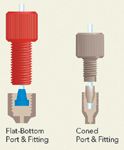HPLC Systems "By the Zones"
To understand how the HPLC system works, it can be useful to first identify the basic components of virtually every system. Armed with that information, envisioning the HPLC system as comprised of three different zones - each with unique characteristics and each with its own set of requirements - can offer further guidance.
Every high perfomance liquid chromatography (HPLC) system is unique, and for many users of traditional HPLC systems, it is not always clear what the basic and essential components of a chromatography system are. However, this knowledge is essential to fully understand how a system works and what accessories (for example, tubing, fittings, and filters) are needed for proper system operation. To aid in this process, it can be useful to first identify the basic components of virtually every LC system. Then, with that information, envisioning the HPLC system as comprised of three different zones — each with unique characteristics and each with its own set of requirements — can offer further guidance.
The ability to customize components to meet the demands of specific analyses and applications has been a characteristic of most chromatography systems for the past two decades. Yet, for all the differentiation between systems, there are certain basic components that must comprise any high performance liquid chromatography (HPLC) system. Understanding what these basic components are — and what each component is required to do — is critical to having a more thorough understanding of how LC systems work overall and subsequently how to best accessorize the fluidic pathway.

Photo Credit: WLADIMIR BULGAR/Getty Images
Apart from the PC (or data collection device), a basic HPLC system is comprised of seven primary components, six of which are required and one that has become so essential to proper system operation that it is built into most new systems available today. These components — in order of appearance in a standard LC system — are as follows:
Component #1 — The Solvent Reservoir: As the name indicates, the solvent reservoir serves as a storage tank for the reagents that will be used as the mobile phase of the system. (The term "mobile phase" refers to chemical reagents that move throughout the fluid pathway.) While only one solvent reservoir is technically needed for a system to be functional, most LC systems typically incorporate 2–4 solvent reservoirs, to allow for binary, tertiary, or quaternary gradient separations.
Component #2 — The Vacuum Degasser: Removing dissolved gasses from the mobile phase near the beginning of the fluidic pathway helps to prevent air bubbles from forming in the check valves of the pump and the pump head. It also helps prevent bubbles from forming post-column and subsequently causing noise and artificial peaks on the chromatogram. The primary method-of-choice for removing dissolved gasses from the mobile phase reagents is vacuum degassing because of its efficiency and portability. In reality, incorporating vacuum degassing or some other degassing method in the LC system is not technically required; however, because of the many benefits offered by vacuum degassing, most systems integrate a vacuum degassing module as part of the primary system hardware.
Component #3 — The Pump:
The pump is responsible for pulling solvent from the solvent reservoir and pushing it out through the rest of the system. It is vital for the pump to provide a stable flow that is virtually free of all pulsation in flow rate, to ensure repeatable separations are possible. While there are numerous pump styles in use today, the two most popular are the binary, high pressure gradient pump, and the quaternary, low pressure gradient pump. The binary option typically integrates two isocratic pumping modules, mixing the output from each module together into a combined stream. The quaternary option, on the other hand, most often utilizes a manifold equipped with solenoid valves on the inlet side of a single pump module, timing the opening and closing of the solenoids with the position of the piston to ensure precise proportioning of up to four different solvents. In each case, the pump modules consist of dual reciprocating pistons, which — when controlled correctly — work together to provide constant, stable flow on the output.
Component #4 — The Injection Valve:
The injection valve is typically a rotary shear valve that has the sole purpose of introducing the sample to be analyzed into the high pressure fluid pathway of the system. While a basic system will simply incorporate a manually actuated injection valve, many modern LC systems have automated the sample introduction process through the use of an autosampler. An autosampler is a device that couples robotics with an electronically actuated injection valve to allow for programmed, unattended sample introduction. Even with the advanced electronics of a typical autosampler, however, the heart of the device remains the injection valve.
Component #5 — The Column:
Most columns are simple tubes that have been densely packed with innumerable spherical beads — each typically 5-μm or less in diameter — and the beads are most often surface-modified to alter the chemical environment inside the column. Because the material packed into the column tubes is bracketed by a filtration disc (or a "frit") on both the inlet and outlet side of the column, the packing material remains in place, even as the mobile phase passes through it. Therefore, the material packed inside the column tube is typically referred to as the stationary phase. The full column assembly is often referred to as the heart of the LC system, for it is within this component that the separation of the sample into its constituent parts occurs. It is the resistance to fluid flow through the densely packed stationary phase of the column that causes the majority of the high pressure for which HPLC is most well-known.
Component #6 — The Detector:
As its name would imply, the detector is responsible for "detecting" the sample components that leave the column. There are numerous types of detectors in use today, incorporating a variety of different technologies (refractive index; fluorescence; chemiluminescence; electrochemistry; mass-to-charge ratio) to help detect the presence of sample components. However, the most commonly-used detector technology incorporated into the majority of LC systems is the UV–vis detector. This type of detector emits light in the full ultraviolet and visible spectra and offers control over the actual wavelength of light that passes through the detector's flow cell (a dual-windowed chamber through which the sample components pass; when exposed to the light, these components absorb some of the light, thereby allowing them to be detected). In more advanced systems, traditional HPLC systems are coupled to a mass spectrometer — this combination is known as liquid chromatography coupled to mass spectrometry (LC–MS). Because of the tremendous flexibility of most modern mass spectrometers to assist in the identification of unknown samples, the use of LC–MS has grown in popularity as one of the most powerful analysis tools available. When a mass spectrometer is used, it sometimes works in tandem with a different detector and at other times takes the place of a more traditional detector.
Component #7 — The Waste Reservoir:
The waste reservoir is most typically a large glass or chemically resistant polymer container into which the mobile phase and sample components flow after separation and detection has taken place, keeping the chemicals stored until they can be safely disposed of.
As mentioned, the components listed above are the basic components of a standard LC system. Many systems will have more than the above-listed components, but they will generally not have less. In fact, aside from the vacuum degasser, if any of the other six components is missing, the resulting system is not truly complete as a fully functional HPLC system.
The Three Zones of the HPLC Fluidic Pathway
Now that the basic LC system has been defined, it can be divided into three separate zones — each with its own unique characteristics that will govern the types of accessories used to complete the fluidic pathway of the system (Figure 1).

Figure 1: This diagram highlights the three primary zones of a standard HPLC system, including the basic system components as well as some primary accessories many users implement.
Zone #1: The first zone begins at the solvent reservoir and extends to the inlet side of the pump, thus including the vacuum degasser as well. In this zone, solvent is pulled by the pump from the solvent reservoir and through the vacuum degasser, generally at a higher speed than it is dispensed. The distinguishing characteristics of this zone are therefore high solvent flow rates and vacuum pressure, as the primary goal in this zone is to ensure unhindered delivery of conditioned mobile phase to the pump. It is important to note, therefore, that, while HPLC is most typically known for the pressure at which it operates, there is typically very little, if any, positive pressure on the fluidic pathway in this zone.
Because of the higher flow rates and the lack of high pressure present in Zone #1, the inner diameter of the flow path tubing will generally be larger than elsewhere in the system. The flow path tubing in this zone is often fluoropolymer tubing, because it offers nearly universal chemical compatibility but does not need to be strong enough to function in the higher pressure environment present elsewhere in the system. In fact, the fluidic pathway tubing can be further customized between the vacuum degasser and the inlet side of the pump by using materials manufactured from ethylene tetrafluoroethylene (ETFE), which offers good chemical inertness and dramatically less gas permeability over other fully fluorinated materials. Filters will be larger in surface area and in porosity. Lastly, the threaded ports most commonly used in Zone #1 are flat-bottom ports, compatible with fittings that are usually described as "low pressure" (Figure 2).

Figure 2: Two of the most-used fitting styles in LC systems - flat-bottom fittings for lower pressure areas, and coned fittings for higher pressure areas.
Zone #2: The second zone in a HPLC system's fluidic pathway begins at the outlet side of the pump and extends to the inlet side of the column, incorporating the injection valve/autosampler in the process. This is the most critical zone of the system for several reasons: 1) The pressures are high; 2) the sample — prior to being separated — is present; and 3) the connections and accessories undergo the most stress in this zone.
(As mentioned earlier, almost all of the high pressure for which HPLC is best known comes from the resistance of fluid flow through the column. As such, high system pressures are typically only present in Zone #2, as it is exclusively in this zone where fluid is pushed against the entire length of the column.)
Because of the conditions and characteristics of the fluidic pathway in this zone, the accessories used here are very different to those in Zone #1. Specifically, in Zone#2 the following most often characterize this section of the LC system fluidic pathway: stronger tubing (for example, PEEK, stainless steel); smaller inner diameters (typically 0.25 mm/0.010" or smaller); an emphasis on fluidic pathways with shorter lengths; filters with smaller porosities and smaller sizes; and high pressure coned fittings (see Figure 2) that mate with receiving ports which feature a coned configuration. All of this is done with the goal of transferring the sample from its source to the column as quickly and with as little dilution as possible, while maintaining the system's ability to withstand the high pressure present in this zone.
Zone #3: The last zone in a HPLC system's fluidic pathway begins at the outlet of the column and extends through to the waste reservoir, including the detector in the process. Throughout this zone the fluidic pressure is positive, but typically significantly lower than in Zone #2. However, in Zone #3, it is common to find a mixture of accessories being used — accessories which mimic Zone #2 accessories (small inner diameter, coned fittings) between the outlet of the column and the inlet of the detector, but often change to accessories with less-stringent performance requirements (larger inner diameter tubing, flat-bottom fittings) once the sample components leave the detector and migrate to the waste reservoir.
It should be noted that there are typically no filters of any kind used in Zone #3, simply because they are not needed. However, a unique accessory — a back pressure regulator — is often used in this zone to help create additional pressure on the fluidic pathway. This in turn helps prevent bubbles from forming in the detector's flow cell because of outgassing of dissolved gases in the mobile phase as it leaves the high pressure environment of the column.
Conclusion
Becoming more familiar with the basic HPLC system components — and having a more thorough understanding of what takes place in each zone of the system — is critical to selecting the appropriate fluidic pathway accessories used throughout the system. Selecting components that are tailored for use in each zone will help ensure proper handling of the mobile phase and the sample. This in turn helps provide a solid foundation to obtaining consistently high-quality chromatographic results.
John Batts joined Upchurch Scientific in 1996 as its first technical specialist and has worked for the company (now IDEX Health & Science) in a variety of roles in the past 18 years. He currently works as a senior-level technical specialist and is also involved in training sessions with customers and employees. Before joining IDEX Health & Science, John worked for the US Food and Drug Administration research laboratory in St Louis, Missouri, USA, as well as in private industry as a chromatographer. John obtained his Bachelor of Arts in Mathematics and Chemistry from Lindenwood University (Missouri, USA), graduating in 1992, and now resides in the Pacific Northwest with his wife and son.
E-mail: technicalsupport.upchurch@idexcorp.com
Website: www.idex-hs.com
This article is from The Column. The full issue can be found here:http://images2.advanstar.com/PixelMags/lctc/digitaledition/October06-2014-uk.html#2

New Study Reviews Chromatography Methods for Flavonoid Analysis
April 21st 2025Flavonoids are widely used metabolites that carry out various functions in different industries, such as food and cosmetics. Detecting, separating, and quantifying them in fruit species can be a complicated process.
Quantifying Terpenes in Hydrodistilled Cannabis sativa Essential Oil with GC-MS
April 21st 2025A recent study conducted at the University of Georgia, (Athens, Georgia) presented a validated method for quantifying 18 terpenes in Cannabis sativa essential oil, extracted via hydrodistillation. The method, utilizing gas chromatography–mass spectrometry (GC–MS) with selected ion monitoring (SIM), includes using internal standards (n-tridecane and octadecane) for accurate analysis, with key validation parameters—such as specificity, accuracy, precision, and detection limits—thoroughly assessed. LCGC International spoke to Noelle Joy of the University of Georgia, corresponding author of this paper discussing the method, about its creation and benefits it offers the analytical community.












